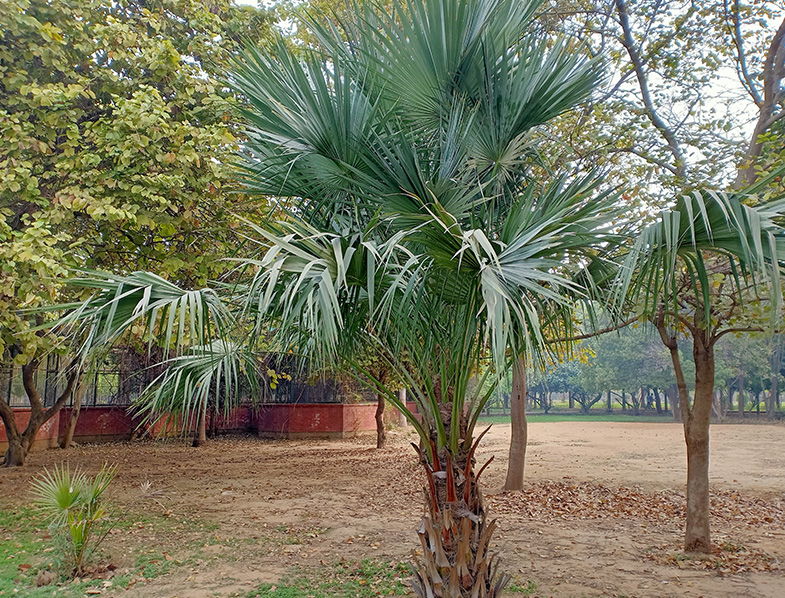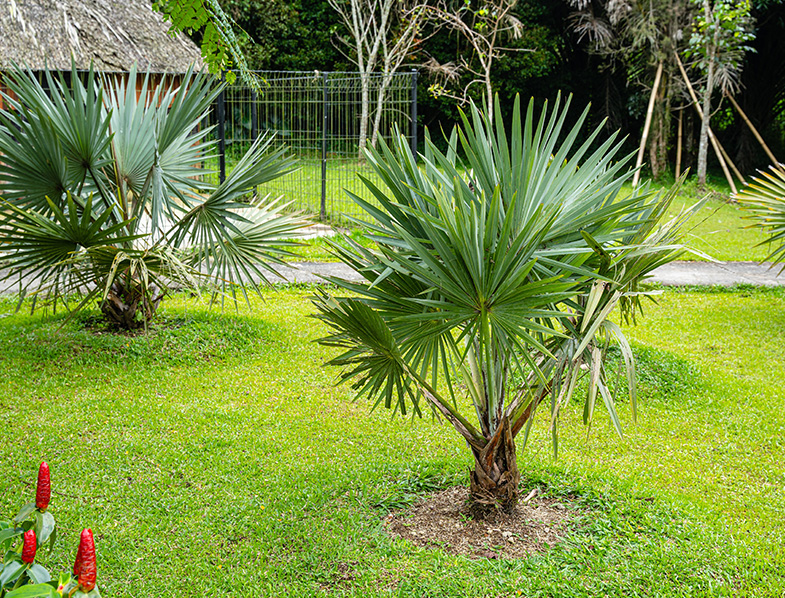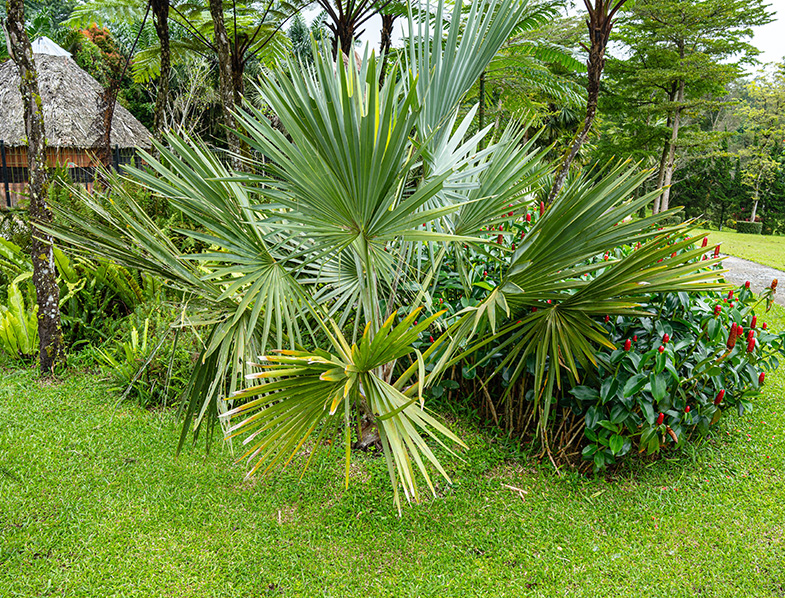If you’re looking for a palm tree that will add a tropical touch to your garden or landscape, the blue hesper palm might be just what you need. With its striking blue-green fronds and sturdy trunk, this palm tree is not only aesthetically pleasing but also surprisingly easy to grow. In this article, we’ll walk you through the step-by-step process of growing a blue hesper palm from choosing the right location to caring for your tree for years to come.
Quick Facts
| Fact Category | Description |
|---|---|
| Scientific Name | Brahea armata |
| Common Name | Blue Hesper Palm |
| Origin | Native to Mexico |
| Maximum Height | Can grow up to 40 feet tall |
| Growth Rate | Slow-growing, can take up to 10 years to reach full height |
| Preferred Climate | Hot, dry climates, cold tolerant down to about 15 degrees Fahrenheit |
| Light Requirements | Full sun to partial shade |
| Soil Type | Prefers well-draining, sandy or loamy soil |
| Watering Needs | Regular watering during first few years, drought-tolerant once established |
| Pruning Needs | Little pruning, only brown or dead fronds need to be removed |
| Fertilizer Needs | Slow-release fertilizer specifically for palm trees |
| Pests and Diseases | Resistant to most, but watch for fungal infections and spider mites |
| Other Key Characteristics | Used as habitat by local wildlife, produces small black edible fruit |
Understanding the Blue Hesper Palm
Origin and Characteristics
The blue hesper palm, also known as the Brahea armata, is a native of Mexico and can grow up to 40 feet tall. Its bluish-green leaves are fan-shaped and up to 5 feet long, and its trunk has a distinctive diamond-shaped pattern created by the leaf bases that remain attached to the trunk. The palm tree produces a small, black fruit that is edible but not widely consumed.
The blue hesper palm is a slow-growing tree that can take up to 10 years to reach its full height. It is also a long-lived tree, with some specimens known to live for over 100 years. The tree’s unique appearance and slow growth make it a popular choice for landscaping in arid regions.
One interesting fact about the blue hesper palm is that it is often used as a habitat by a variety of animals in its native range. Birds, bats, and insects all make their homes in the tree’s leaves and trunk, making it an important part of the local ecosystem.
Ideal Growing Conditions
A blue hesper palm prefers a hot, dry climate and is cold tolerant down to about 15 degrees Fahrenheit. It grows best in full sun to partial shade and requires well-draining soil. The palm tree is drought tolerant once established but will benefit from regular watering during its first few years of growth.
While the blue hesper palm can tolerate a range of soil types, it prefers sandy or loamy soil. It is important to note that the tree does not do well in areas with high humidity or frequent rainfall, as this can lead to fungal diseases and other problems.
When planting a blue hesper palm, it is important to choose a location that is sheltered from strong winds, as the tree’s leaves can be easily damaged. It is also a good idea to plant the tree away from buildings or other structures, as its roots can be quite large and may cause damage over time.
Overall, the blue hesper palm is a fascinating and unique tree that is well-suited to arid climates. Its striking appearance and importance to local wildlife make it a popular choice for landscaping and conservation efforts alike.

Preparing for Planting
Planting a blue hesper palm can add a stunning element to your landscape. With its unique blue-green fronds and tall stature, it is sure to make a statement. However, before planting your blue hesper palm, there are a few things to consider to ensure its success.
Choosing the Right Location
One of the most important factors to consider when planting a blue hesper palm is choosing the right location. Before selecting a spot, consider the size of the tree at maturity. The blue hesper palm can grow up to 30 feet tall and 20 feet wide, so ensure that you have enough space for it to grow without interfering with structures or power lines.
In addition to space, the blue hesper palm also requires plenty of sunlight to thrive. Look for a location that receives full sun for most of the day. This tree also prefers well-draining soil, so avoid planting it in an area that is prone to standing water.
Soil Preparation and Drainage
Proper soil preparation is key to the success of your blue hesper palm. This tree can tolerate both sandy and clay soils, but it prefers soil that is well-draining. If you have heavy clay soil, you may need to amend it with organic matter to improve drainage. This can include adding compost, peat moss, or sand to the soil.
It is important to avoid planting your palm tree in soil that is constantly damp, as this can lead to root rot. If you are unsure about the drainage in your chosen location, you can perform a simple soil test to determine the soil’s drainage capacity.
Selecting a Healthy Blue Hesper Palm
When selecting a blue hesper palm, it is important to choose a healthy tree that will adapt well to its new environment. Look for a tree with a sturdy trunk, healthy foliage, and no signs of pests or disease. Avoid transplanting a tree with roots that are pot-bound or that have been severely pruned, as these trees may have a harder time adapting to a new environment.
By following these guidelines, you can ensure that your blue hesper palm has the best chance of thriving in its new home. With proper care and maintenance, your palm tree can provide beauty and shade for years to come.

Planting Your Blue Hesper Palm
Are you ready to add a stunning blue hesper palm to your landscape? Follow these steps to ensure your palm tree thrives:
Digging the Hole
When choosing a spot for your blue hesper palm, consider the tree’s mature size. These palms can grow up to 30 feet tall and 15 feet wide, so you’ll want to choose a location that allows for plenty of space. Before planting, dig a hole twice as wide as the root ball and slightly shallower than the depth of the root ball. This will allow enough room for the roots to spread out and establish themselves in the soil.
Positioning the Palm
Once you’ve dug your hole, carefully position the blue hesper palm in the middle of the hole. It’s important to ensure that the tree is straight, so take your time to adjust the positioning as needed. Once the tree is in the desired position, backfill the hole with soil, tamping down gently around the root ball to remove any air pockets.
Filling and Watering
Now that your tree is planted, it’s time to give it some water. Fill the hole with soil up to the base of the tree and water the tree thoroughly to settle the soil and encourage root growth. For the first few years after planting, water your palm tree regularly to help it become established. Blue hesper palms prefer well-draining soil and can benefit from occasional fertilization to promote healthy growth.
With proper care, your blue hesper palm can become a stunning centerpiece in your landscape, providing shade and beauty for years to come.
Caring for Your Blue Hesper Palm
The blue hesper palm, also known as the brahea armata, is a stunning tree that can add a touch of the exotic to any landscape. Native to Mexico, this palm tree is known for its striking blue-grey foliage and impressive size, which can reach up to 50 feet tall and 20 feet wide.
Watering and Fertilizing
After the first few years of establishment, the blue hesper palm is quite drought tolerant and can handle periods of dryness. However, during hot and dry periods, it’s a good idea to water your palm tree regularly. Be sure to water deeply, allowing the water to reach the roots, and avoid watering the fronds or foliage.
When it comes to fertilizing your blue hesper palm, it’s important to choose a slow-release fertilizer that is specifically formulated for palm trees. Apply the fertilizer in the spring and summer months, following the instructions on the package carefully. Avoid over-fertilizing, as this can lead to root burn and damage.
Pruning and Maintenance
Regular pruning is not required for the blue hesper palm, other than removing any fronds that have turned brown or died. Do not remove green fronds, as this can damage the tree and stunt its growth. It’s also important to avoid pruning the tree during the summer months, as this can cause stress and damage to the tree.
When it comes to maintenance, keeping the area around your palm tree clear of debris and weeds is crucial. This will help prevent pests and disease from taking hold and ensure that your tree stays healthy. You can also add a layer of mulch around the base of the tree to retain moisture and promote soil health.
Pest and Disease Control
The blue hesper palm is relatively disease and pest resistant, but it can be susceptible to some fungal infections and spider mites. Keep an eye out for any signs of discoloration or unusual growth and take action promptly to prevent the spread of disease.
To prevent pest infestations, it’s important to keep your palm tree healthy and well-maintained. This includes regular watering and fertilizing, as well as keeping the area around the tree clear of debris and weeds.

Conclusion
Growing a blue hesper palm is a rewarding experience that will add a touch of the tropics to your yard or garden. With proper care and maintenance, your palm tree can thrive for years to come. Whether you’re a seasoned gardener or a beginner, the blue hesper palm is a great choice for anyone looking to add a touch of exotic beauty to their landscape.
Blue Hesper Palm FAQS
How do you grow a blue Hesper palm from seed?
Growing a blue Hesper palm from seed requires some patience. Start by soaking the seeds in warm water for 24-48 hours to help break seed dormancy. Then, plant the seeds in a well-draining seed starting mix, burying them about 1/2 inch deep. Keep the seeds at a temperature of about 70-85 degrees Fahrenheit and ensure the soil remains consistently moist but not waterlogged. Germination can take several weeks to a few months.
How do I get my palm tree to grow?
To encourage growth in your palm tree, ensure that it is getting enough sunlight and is planted in well-draining soil. Regular watering is crucial, especially in the first few years, but ensure not to overwater. Using a slow-release fertilizer designed for palm trees during the growing season can also support healthy growth.
How tall do blue palms get?
Blue Hesper palms, also known as Brahea armata, can reach up to 40 feet in height. It’s a slow-growing species, taking up to 10 years to reach its full height.
What is the best fertilizer for European fan palms?
European fan palms (Chamaerops humilis) will benefit from a balanced, slow-release palm fertilizer. Look for a fertilizer that contains a ratio of Nitrogen (N), Phosphorous (P), and Potassium (K), along with minor trace elements such as magnesium, iron, and manganese, which are essential for palm health.
How often should I water my fan palm?
Fan palms generally need watering once a week during hot, dry periods, and less frequently during cooler months or in more humid climates. The key is to water deeply and allow the soil to dry out between watering to avoid waterlogged conditions which can lead to root rot.
Do fan palms need a lot of water?
Fan palms are relatively drought-tolerant once established but will benefit from regular watering during hot and dry periods. It’s crucial to ensure that the palm is planted in well-draining soil as it does not tolerate waterlogged conditions well. Overwatering can lead to problems such as root rot. As a general rule, water deeply once a week during dry periods and less frequently during the cooler months.
